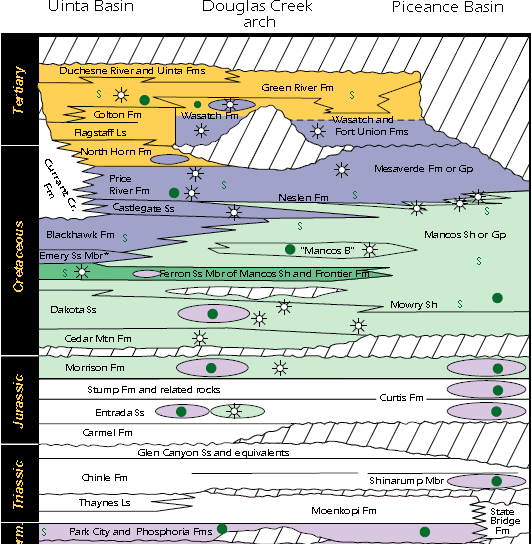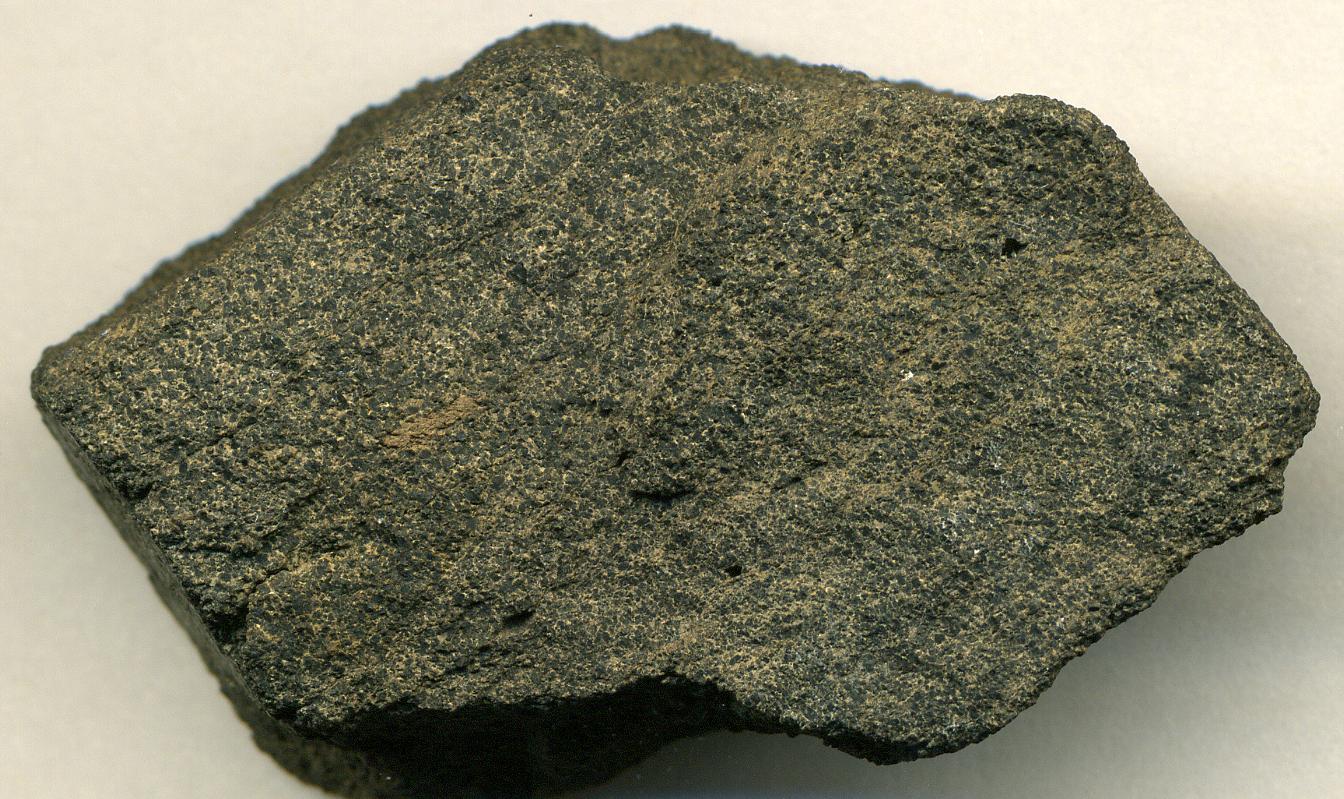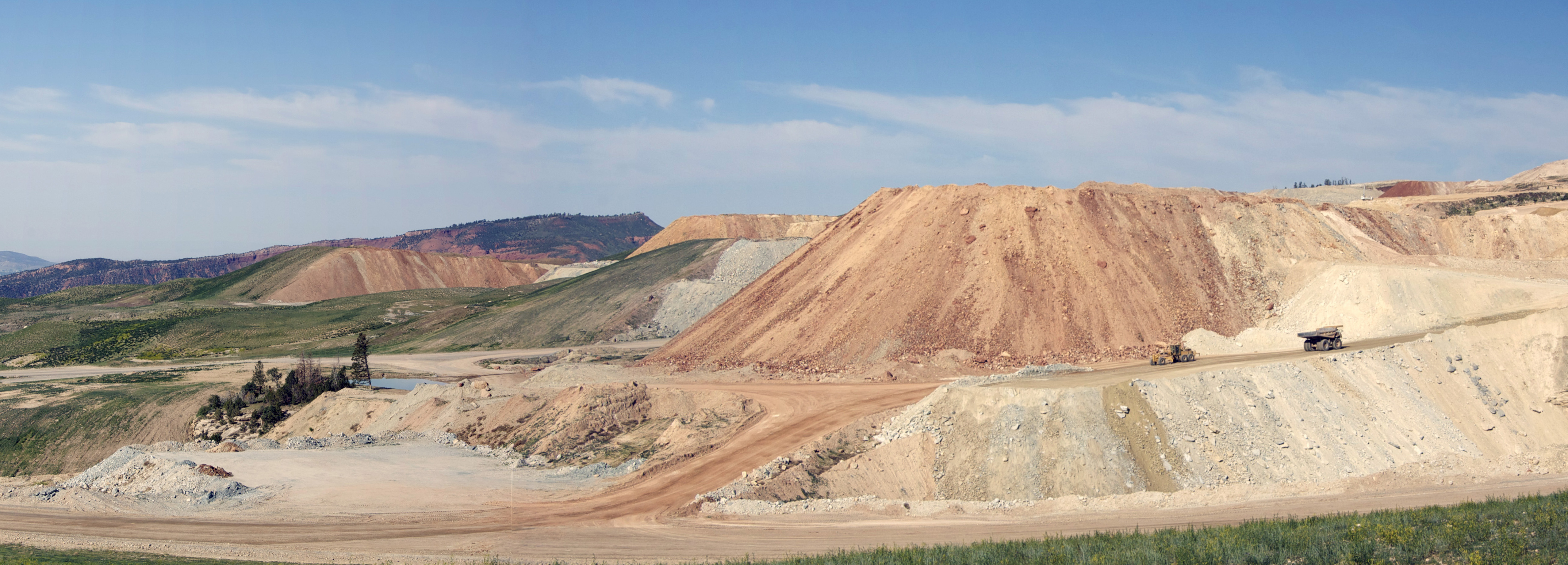Phosphoria Formation on:
[Wikipedia]
[Google]
[Amazon]
 The Phosphoria Formation of the western
The Phosphoria Formation of the western


"Rocky Mountain to sell Paris Hills phosphate/vanadium property in Idaho"
''Proactive Investors'', 12 Oct. 2009.
 The Phosphoria Formation of the western
The Phosphoria Formation of the western United States
The United States of America (U.S.A. or USA), commonly known as the United States (U.S. or US) or America, is a country primarily located in North America. It consists of 50 states, a federal district, five major unincorporated territori ...
is a geological formation
A geological formation, or simply formation, is a body of rock having a consistent set of physical characteristics ( lithology) that distinguishes it from adjacent bodies of rock, and which occupies a particular position in the layers of rock exp ...
of Early Permian age.Behnken, F.H., Wardlaw, B.R. and Stout, L.N., 1986, Conodont biostratigraphy of the Permian Meade Peak Phosphatic Shale Member, Phosphoria Formation, southeastern Idaho. University of Wyoming Contributions to Geology, v. 24, no. 2, p. 169-190. It represents some 15 million years of sedimentation, reaches a thickness of and covers an area of .Blatt, Harvey and Robert J. Tracy, ''Petrology'', Freeman, 1996, 2nd ed. pp. 345-349
The Phosphoria includes phosphorite beds that are an important source of phosphorus
Phosphorus is a chemical element with the symbol P and atomic number 15. Elemental phosphorus exists in two major forms, white phosphorus and red phosphorus, but because it is highly reactive, phosphorus is never found as a free element on Ear ...
. Many of its shales are rich in organic matter and are petroleum source rocks, and some of its dolomite Dolomite may refer to:
*Dolomite (mineral), a carbonate mineral
*Dolomite (rock), also known as dolostone, a sedimentary carbonate rock
*Dolomite, Alabama, United States, an unincorporated community
*Dolomite, California, United States, an unincor ...
s include petroleum reservoirs.
Environment of deposition
The Phosphoria Formation was deposited under marine conditions in a foreland basin located between thePaleozoic
The Paleozoic (or Palaeozoic) Era is the earliest of three geologic eras of the Phanerozoic Eon.
The name ''Paleozoic'' ( ;) was coined by the British geologist Adam Sedgwick in 1838
by combining the Greek words ''palaiós'' (, "old") and ' ...
continental margin and the North American cratonic shelf.Maughan, E.K. 1984. Geological setting and some geochemistry of petroleum source rocks in the Permian Phosphoria Formation. Rocky Mountain Association of Geologists. The upwelling of cold, nutrient-rich marine water at that time stimulated the growth of plankton
Plankton are the diverse collection of organisms found in water (or air) that are unable to propel themselves against a current (or wind). The individual organisms constituting plankton are called plankters. In the ocean, they provide a crucia ...
and nekton
Nekton or necton (from the ) refers to the actively swimming aquatic organisms in a body of water. The term was proposed by German biologist Ernst Haeckel to differentiate between the active swimmers in a body of water, and the passive organisms t ...
, resulting in the accumulation of organic matter on the sea floor. That, coupled with low rates of clastic and carbonate
A carbonate is a salt of carbonic acid (H2CO3), characterized by the presence of the carbonate ion, a polyatomic ion with the formula . The word ''carbonate'' may also refer to a carbonate ester, an organic compound containing the carbonate ...
sedimentation, led to the high phosphate
In chemistry, a phosphate is an anion, salt, functional group or ester derived from a phosphoric acid. It most commonly means orthophosphate, a derivative of orthophosphoric acid .
The phosphate or orthophosphate ion is derived from phosph ...
and hydrocarbon
In organic chemistry, a hydrocarbon is an organic compound consisting entirely of hydrogen and carbon. Hydrocarbons are examples of group 14 hydrides. Hydrocarbons are generally colourless and hydrophobic, and their odors are usually weak or ...
content of the formation, as well as elevated levels of cadmium
Cadmium is a chemical element with the symbol Cd and atomic number 48. This soft, silvery-white metal is chemically similar to the two other stable metals in group 12, zinc and mercury. Like zinc, it demonstrates oxidation state +2 in most of ...
, chromium, copper
Copper is a chemical element with the symbol Cu (from la, cuprum) and atomic number 29. It is a soft, malleable, and ductile metal with very high thermal and electrical conductivity. A freshly exposed surface of pure copper has a pinkis ...
, fluorine, molybdenum, nickel
Nickel is a chemical element with symbol Ni and atomic number 28. It is a silvery-white lustrous metal with a slight golden tinge. Nickel is a hard and ductile transition metal. Pure nickel is chemically reactive but large pieces are slow ...
, rare earth elements
The rare-earth elements (REE), also called the rare-earth metals or (in context) rare-earth oxides or sometimes the lanthanides (yttrium and scandium are usually included as rare earths), are a set of 17 nearly-indistinguishable lustrous sil ...
, selenium
Selenium is a chemical element with the symbol Se and atomic number 34. It is a nonmetal (more rarely considered a metalloid) with properties that are intermediate between the elements above and below in the periodic table, sulfur and tellurium, ...
, uranium
Uranium is a chemical element with the symbol U and atomic number 92. It is a silvery-grey metal in the actinide series of the periodic table. A uranium atom has 92 protons and 92 electrons, of which 6 are valence electrons. Uranium is weak ...
, vanadium, and zinc
Zinc is a chemical element with the symbol Zn and atomic number 30. Zinc is a slightly brittle metal at room temperature and has a shiny-greyish appearance when oxidation is removed. It is the first element in group 12 (IIB) of the periodi ...
.
Stratigraphy and lithology
The formation is commonly subdivided, from the top downward, as follows: * The Tosi chert member (chert
Chert () is a hard, fine-grained sedimentary rock composed of microcrystalline or cryptocrystalline quartz, the mineral form of silicon dioxide (SiO2). Chert is characteristically of biological origin, but may also occur inorganically as a ...
with limestone
Limestone ( calcium carbonate ) is a type of carbonate sedimentary rock which is the main source of the material lime. It is composed mostly of the minerals calcite and aragonite, which are different crystal forms of . Limestone forms whe ...
at base).
* The Retort phosphatic member (phosphorite, dolomite Dolomite may refer to:
*Dolomite (mineral), a carbonate mineral
*Dolomite (rock), also known as dolostone, a sedimentary carbonate rock
*Dolomite, Alabama, United States, an unincorporated community
*Dolomite, California, United States, an unincor ...
, and siltstone).
* The Rex chert member (gray limestone at base, black chert, and black cherty shale).
* The Meade Peak phosphatic member (interbedded brown to black shale, gray dense limestone, dark brown oolitic phosphorite, and minor white calcareous
Calcareous () is an adjective meaning "mostly or partly composed of calcium carbonate", in other words, containing lime or being chalky. The term is used in a wide variety of scientific disciplines.
In zoology
''Calcareous'' is used as an ad ...
sandstone
Sandstone is a clastic sedimentary rock composed mainly of sand-sized (0.0625 to 2 mm) silicate grains. Sandstones comprise about 20–25% of all sedimentary rocks.
Most sandstone is composed of quartz or feldspar (both silicates ...
).
* The Lower Chert member (dark cherty shale).
The Phosphoria is underlain by the Pennsylvanian-Permian Casper Formation
The Casper Formation is a geologic formation in Wyoming, USA. It preserves fossils dating back to the Pennsylvanian period.
See also
* List of fossiliferous stratigraphic units in Wyoming
* Paleontology in Wyoming
Paleontology in Wyoming inc ...
or, depending on the location, by the Park City Formation
The Park City Formation is a geologic formation in Montana and Utah. It preserves fossils dating back to the Permian period.
See also
* List of fossiliferous stratigraphic units in Montana
This article contains a list of fossil-bearing strat ...
or the Tensleep Sandstone
The Tensleep Sandstone is a geological formation of Pennsylvanian to very early Permian age in Wyoming.
The formation is composed of fine- to medium-grained sandstone, light gray and yellowish gray; generally slightly to moderately calcareous; s ...
, and it is overlain by the Triassic Dinwoody Formation
The Dinwoody Formation is a geologic formation in Montana. It preserves fossils dating back to the Triassic period.
See also
* List of fossiliferous stratigraphic units in Montana
* Paleontology in Montana
Paleontology in Montana refers to pale ...
. The upper boundary is placed at the top of the uppermost phosphorite bed and below the tan calcareous siltstone of Dinwoody formation. The lower boundary is marked by a thin phosphorite that contains abundant fish scale
A fish scale is a small rigid plate that grows out of the skin of a fish. The skin of most jawed fishes is covered with these protective scales, which can also provide effective camouflage through the use of reflection and colouration, as ...
s and bones.McKelvey, V.E., Cheney, T.M., Cressman, E.R., Sheldon, R.P., Swanson, R.W. and Williams, J. Steele, 1959. The Phosphoria, Park City, and Shedhorn formations in the western phosphate field. In: Geology of Permian rocks in the western phosphate field, U.S. Geological Survey Professional Paper 313-A, p. A1-A47.
Thickness and distribution
The formation reaches its greatest thickness in theSublett Range
The Sublett Range is a mountain range in the U.S. states of Idaho (~94%) and Utah (~6%), spanning Cassia, Oneida, and Power counties, Idaho and reaching into Box Elder County, Utah. The Phosphoria Formation reaches its greatest thickness beneath ...
in the Paleozoic
The Paleozoic (or Palaeozoic) Era is the earliest of three geologic eras of the Phanerozoic Eon.
The name ''Paleozoic'' ( ;) was coined by the British geologist Adam Sedgwick in 1838
by combining the Greek words ''palaiós'' (, "old") and ' ...
cordilleran structural basin of southern Idaho. Within the basin the formation consists of a basal phosphorite overlain by a thick sequence of chert
Chert () is a hard, fine-grained sedimentary rock composed of microcrystalline or cryptocrystalline quartz, the mineral form of silicon dioxide (SiO2). Chert is characteristically of biological origin, but may also occur inorganically as a ...
and cherty sandstone
Sandstone is a clastic sedimentary rock composed mainly of sand-sized (0.0625 to 2 mm) silicate grains. Sandstones comprise about 20–25% of all sedimentary rocks.
Most sandstone is composed of quartz or feldspar (both silicates ...
. To the east in western Wyoming the Phosphoria gradually decreases in thickness and is intertongued with carbonate rock
Carbonate rocks are a class of sedimentary rocks composed primarily of carbonate minerals. The two major types are limestone, which is composed of calcite or aragonite (different crystal forms of CaCO3), and dolomite rock (also known as dolosto ...
s of the Park City Formation
The Park City Formation is a geologic formation in Montana and Utah. It preserves fossils dating back to the Permian period.
See also
* List of fossiliferous stratigraphic units in Montana
This article contains a list of fossil-bearing strat ...
and redbed
Red beds (or redbeds) are sedimentary rocks, typically consisting of sandstone, siltstone, and shale, that are predominantly red in color due to the presence of ferric oxides. Frequently, these red-colored sedimentary strata locally contain th ...
sandstones of the Chugwater Formation
The Chugwater Formation is a mapped bedrock unit consisting primarily of red sandstone, in the states of Wyoming, Montana, and Colorado in the United States. It is recognized as a geologic formation in Colorado and Montana, but as a Group (set of ...
of Permian to Triassic
The Triassic ( ) is a geologic period and system (stratigraphy), system which spans 50.6 million years from the end of the Permian Period 251.902 million years ago (Year#Abbreviations yr and ya, Mya), to the beginning of the Jurassic Period 201.36 ...
age. The Phosphoria units extend into the Wind River Mountains
The Wind River Range (or "Winds" for short) is a mountain range of the Rocky Mountains in western Wyoming in the United States. The range runs roughly NW–SE for approximately . The Continental Divide follows the crest of the range and incl ...
and pinch out in the Green Mountains
The Green Mountains are a mountain range in the U.S. state of Vermont. The range runs primarily south to north and extends approximately from the border with Massachusetts to the border with Quebec, Canada. The part of the same range that is i ...
to the east.
Paleontology
Fossils recovered from the Phosphoria Formation includebrachiopod
Brachiopods (), phylum Brachiopoda, are a phylum of trochozoan animals that have hard "valves" (shells) on the upper and lower surfaces, unlike the left and right arrangement in bivalve molluscs. Brachiopod valves are hinged at the rear end, w ...
s, sponge spicules, crinoid stems, conodont elements, and fish scales and bones. Most "tooth whorls" of the enigmatic cartilaginous fish ''Helicoprion
''Helicoprion'' is an extinct genus of shark-like eugeneodont fish. Almost all fossil specimens are of spirally arranged clusters of the individuals' teeth, called "tooth whorls", which in life were embedded in the lower jaw. As with most extin ...
'' are known from the formation, including the only known specimen with preserved cranial remains. The Early Permian age of the formation is based primarily on conodont biostratigraphy
Biostratigraphy is the branch of stratigraphy which focuses on correlating and assigning relative ages of rock strata by using the fossil assemblages contained within them.Hine, Robert. “Biostratigraphy.” ''Oxford Reference: Dictionary of B ...
.
Economic resources


Phosphorus
The Phosphoria phosphorite beds have been mined forphosphorus
Phosphorus is a chemical element with the symbol P and atomic number 15. Elemental phosphorus exists in two major forms, white phosphorus and red phosphorus, but because it is highly reactive, phosphorus is never found as a free element on Ear ...
, which is used primarily for fertilizer production, in southeastern Idaho
Idaho ( ) is a state in the Pacific Northwest region of the Western United States. To the north, it shares a small portion of the Canada–United States border with the province of British Columbia. It borders the states of Montana and Wyomi ...
, northern Utah
Utah ( , ) is a state in the Mountain West subregion of the Western United States. Utah is a landlocked U.S. state bordered to its east by Colorado, to its northeast by Wyoming, to its north by Idaho, to its south by Arizona, and to it ...
, western Wyoming
Wyoming () is a state in the Mountain West subregion of the Western United States. It is bordered by Montana to the north and northwest, South Dakota and Nebraska to the east, Idaho to the west, Utah to the southwest, and Colorado to the s ...
, and southwestern Montana
Montana () is a state in the Mountain West division of the Western United States. It is bordered by Idaho to the west, North Dakota and South Dakota to the east, Wyoming to the south, and the Canadian provinces of Alberta, British Columb ...
.
Uranium
Low concentrations ofuranium
Uranium is a chemical element with the symbol U and atomic number 92. It is a silvery-grey metal in the actinide series of the periodic table. A uranium atom has 92 protons and 92 electrons, of which 6 are valence electrons. Uranium is weak ...
are present in the Phosphoria phosphorite beds but are not considered to be of economic interest.
Vanadium
A vanadium-enriched zone that is present in western Wyoming and southeastern Idaho contains potentially economic concentrations of vanadium in some areas.''Proactive Investors'', 12 Oct. 2009.
Petroleum
Petroleum
Petroleum, also known as crude oil, or simply oil, is a naturally occurring yellowish-black liquid mixture of mainly hydrocarbons, and is found in geological formations. The name ''petroleum'' covers both naturally occurring unprocessed crud ...
has been produced from some of the dolomite Dolomite may refer to:
*Dolomite (mineral), a carbonate mineral
*Dolomite (rock), also known as dolostone, a sedimentary carbonate rock
*Dolomite, Alabama, United States, an unincorporated community
*Dolomite, California, United States, an unincor ...
s in the Phosphoria Formation,Campbell, C.V. 1962. Depositional environments of Phosphoria Formation (Permian) in southeastern Bighorn basin, Wyoming. AAPG Bulletin 46(4): 478-503. and many of the Phosphoria shales are rich in organic matter and are petroleum source rocks.
See also
Phosphate mining in the United States
In 2015, 27.6 million metric tons of marketable phosphate rock, or phosphorite, was mined in the United States, making the US the world's third-largest producer, after China and Morocco. The phosphate mining industry employed 2,200 people. The valu ...
References
{{Chronostratigraphy of Colorado, Paleozoic state=expanded Shale formations of the United States Geologic formations of Idaho Geologic formations of Montana Geologic formations of Wyoming Geology of the Rocky Mountains Permian geology of Nevada Permian Idaho Permian geology of Montana Permian geology of Utah Permian Wyoming Cisuralian Series of North America